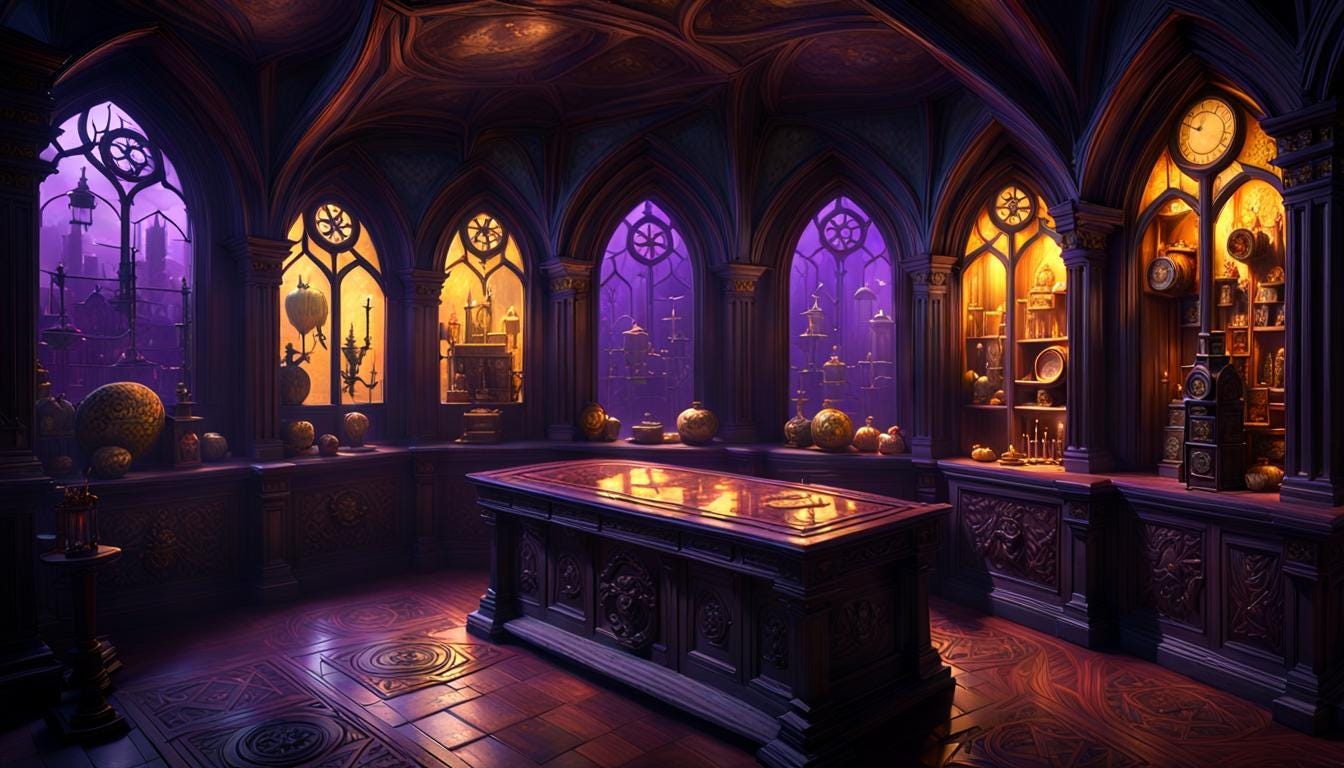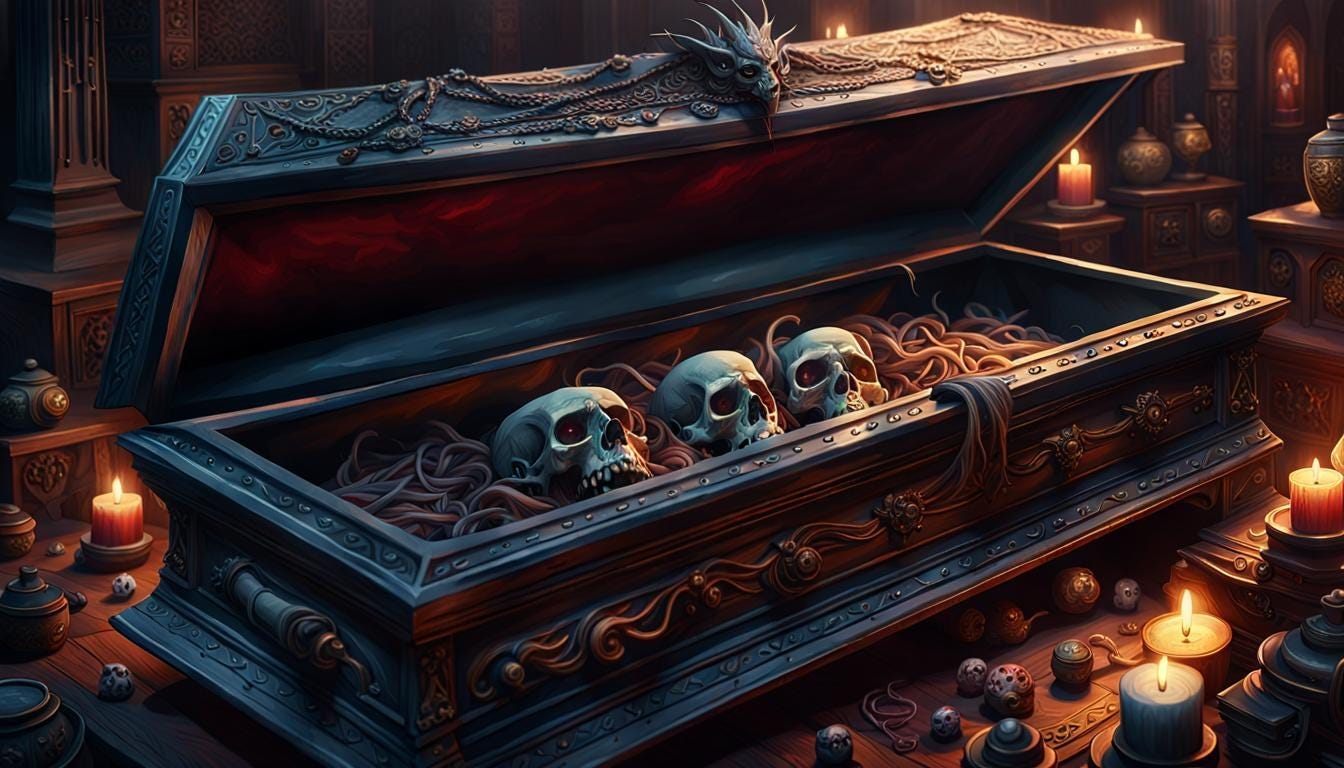Hi all
Here is a poem that I will publish on Medium shortly. It’s a free verse poem, so there is really no restriction on meter, rhyme, format etc.
But this is poetry, so it must satisfy some criteria, rather than just be a stream of unconnected words and phrases (though some might say that this also is poetry)
Let’s look at it anyway:
Opening a Cabinet of Curios
A poem

The chipwork latch gives way
with a creak and sigh,
the cupboard’s moustached lip
uncurling a secret grin.
A waft of naphthalene and eld,
the scent of heirlooms lingering,
as I brush aside the cobwebs,
antique lace kissing my fingertips.
Behind bevelled glass panes
a menagerie of bygones rests,
curios, brittle scraps of lore,
each one whispering its haunted genesis.
A mourning locket, enamel petals
cradling a faded swirl of ash-blond hair.
A cameo brooch, creamed alabaster
echoing the curve of a bygone beauty’s cheek.
There, a jar of bone-dry rosebuds,
culled from the grave of a stillborn babe,
and pressed amidst vellum sheets,
wildflowers from the meadow she’d never roam.
These shelves groan under
the weight of loss made relic,
mementoes honouring the white shadows
that haunted these halls before me.
My name unspoken on their delicate lips,
yet in their brittle arms they embrace me,
the keeper of her melancholic legions,
the tender of her sorrowed things.
That’s the poem. So let’s look at a few aspects of it that hopefully will both help you to understand why I have used this subject, and also why I chose the phrases in it.
Deconstructing "Opening a Cabinet of Curios": A Poetic Analysis
In this evocative free verse poem "Opening a Cabinet of Curios," I weave together a tale of rich imagery, haunting metaphors, and a palpable sense of melancholy – inviting the reader to be immersed in a world of bygone relics and the spectral remnants of lost lives.
Structure
From the outset, the poem's structure mirrors the act of opening the cabinet itself, with the first line describing the "chipwork latch" giving way with a "creak and sigh." This sensory detail not only sets the stage but also imbues the act of opening the cabinet with a sense of reverence and anticipation.
The subsequent lines unfurl like the "moustached lip" of the cabinet, revealing the treasures within in, a cascading, almost cinematic manner. The use of enjambment and the shifting line lengths create a sense of rhythm and pacing that echoes the exploratory nature of the narrative.
Imagery and Symbolism
Vivid, evocative imagery draws the reader into the cabinet's dimly lit interior. The "waft of naphthalene and eld" and the "cobwebs, antique lace kissing my fingertips" immediately conjure a palpable atmosphere of antiquity and decay – setting the stage for the haunting relics that await.
The "menagerie of bygones" that rests behind the "bevelled glass panes" is where the true magic of the poem unfolds. Each item, from the "mourning locket" to the "jar of bone-dry rosebuds," becomes a vessel for a lost story, a spectral echo of lives and loves that have long since faded.
The power of these objects lies in their ability to transcend their physical form and become symbols of a profound, melancholic past. The "faded swirl of ash-blond hair" in the locket and the "wildflowers from the meadow she'd never roam" speak volumes about the individuals they represent, inviting the reader to ponder the unseen tales that haunt these halls.
Metaphorical Depth
Woven throughout the poem is an atmoshere of metaphorical resonance, elevating the simple act of opening a cabinet into a meditation on the nature of memory, grief, and the human condition.
The cabinet itself becomes a metaphor for the fragility of life, its "moustached lip uncurling a secret grin" hinting at the capricious and often cruel nature of mortality. The relics within, carefully preserved yet forever frozen in time, are a poignant reminder of the transience of human existence and the ways in which we seek to immortalize our loved ones through material means.
Moreover, the notion of the narrator as the "keeper of her melancholic legions" and the "tender of her sorrowed things" imbues the poem with a profound sense of responsibility and reverence. The narrator becomes a conduit, a guardian of the stories and emotions that emanate from these relics, serving as a bridge between the present and the spectral past.
Emotional Resonance
Underpinning the vivid imagery and metaphorical depth of "Opening a Cabinet of Curios" is a palpable sense of melancholy and loss. The poem invites the reader to bear witness to the fragile, haunting traces of lives that have long since slipped beyond the veil of the physical world.
The tenderness with which the narrator handles these relics, the way they "embrace me" and speak to the narrator "with their delicate lips," evokes a profound sense of empathy and connection. We, as readers, are drawn into the narrator's journey of discovery, compelled to contemplate the weight of history and the indelible marks that the departed have left upon the world.
In this way, the poem goes beyond the specific contents of the cabinet and becomes a universal meditation on the human experience – the ways in which we mourn, commemorate, and ultimately come to terms with the inevitability of loss and the fleeting nature of existence.
End note
Be aware that this is not a critique of the poem. A critique would point out any failings as well as highlighting the good points, while giving advice on any improvements needed.
This brings me nicely to next week’s newsletter, where I’ll present another short poem, but this time will show a light critique, and then a more in-depth critique, to show how a proper reviewer would view the poem, if asked to critique in a professional manner.
See you all next week.
Tom





